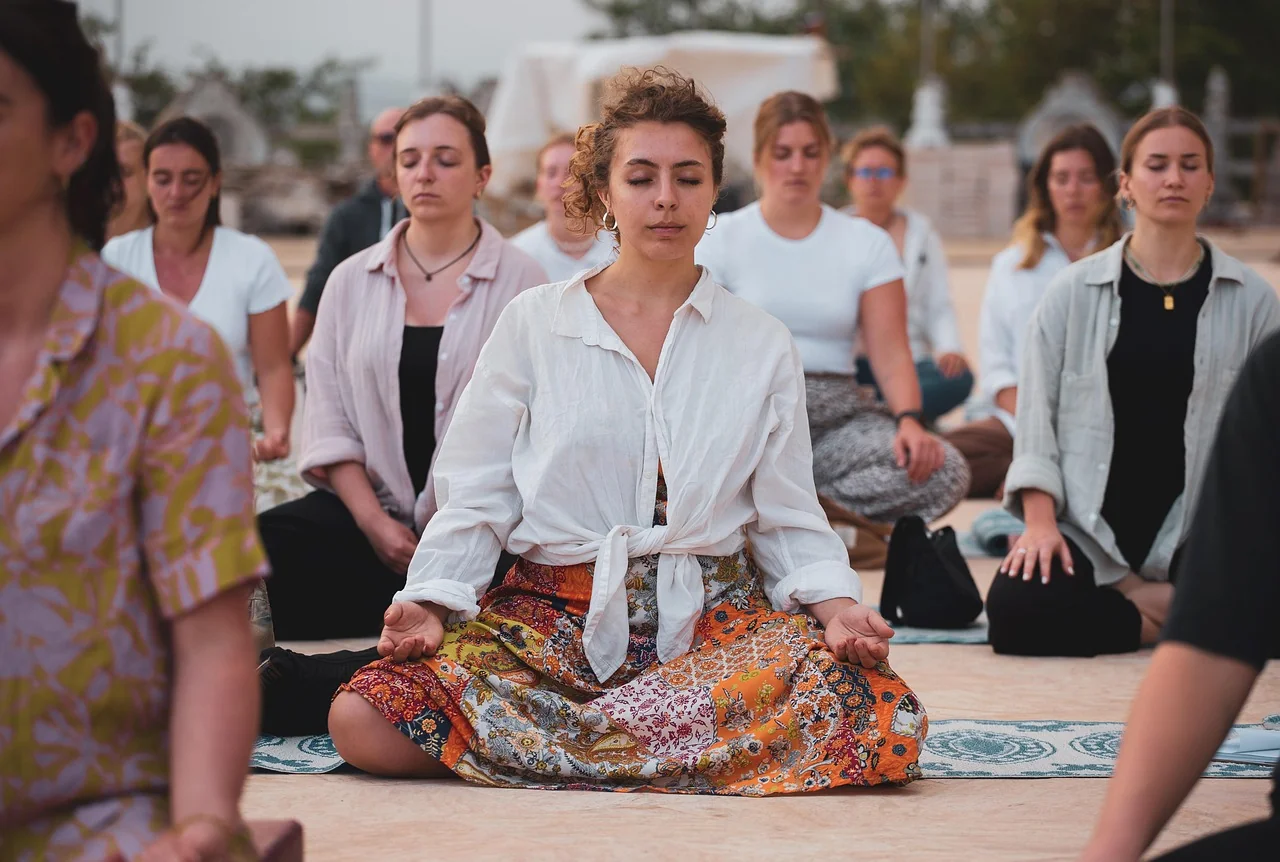In our fast-paced, hyper-connected world, the search for a moment of true quiet can feel endless. You may have tried modern wellness apps and quick-fix stress solutions, only to find the peace they offer is fleeting. To discover a practice of profound and lasting transformation, we must return to the source. This is the world of traditional meditation—not merely a relaxation technique, but a centuries-old spiritual discipline for awakening.
This isn't about emptying your mind, but about understanding it. Rooted in the ancient wisdom of Buddhist, Hindu, and Taoist paths, traditional meditation is a journey inward to cultivate mindfulness, compassion, and unwavering inner stillness. In this complete guide, we will demystify its core philosophies, walk you through foundational techniques, and reveal the science-backed benefits that make this ancient practice more relevant than ever. Ready to journey to the heart of mindfulness? Let's begin.
What is Traditional Meditation? A Journey to the Source
Traditional meditation is a deep and systematic practice rooted in the ancient spiritual and philosophical systems of the East. Unlike many modern, secular approaches that primarily focus on stress reduction or improved focus, traditional meditation is a holistic discipline aimed at self-discovery, profound inner peace, and, in many traditions, enlightenment or spiritual awakening.
At its core, it is a training of the mind and heart. It’s not about stopping your thoughts or achieving a blank state of mind—an impossible task for any active brain. Instead, it’s about changing your relationship with your thoughts. You learn to observe the constant stream of your internal experience—thoughts, emotions, bodily sensations—without getting swept away by them. This shift from being a participant in your mental chatter to being a witness of it is the fundamental transformation that traditional practices offer. It’s a journey to the source of your own consciousness.
Tracing the Roots: A Brief History of Traditional Meditation Practices
The story of traditional meditation is a rich tapestry woven across continents and cultures over thousands of years. Understanding its origins gives depth and context to the practice itself.
Origins in Ancient India: The earliest written records of structured meditation practices come from the Hindu traditions of India, found in the Vedas and the later Upanishads (around 1500–500 BCE). These texts described meditative techniques as a means to understand the true nature of the self (Atman) and its connection to ultimate reality (Brahman). This era also saw the development of Yoga, with Patanjali’s Yoga Sutras systematically outlining meditation as a key step toward spiritual liberation.
The Buddhist Contribution: In the 5th century BCE, Siddhartha Gautama, the Buddha, placed meditation at the very center of his path to end suffering. He mastered existing yogic practices and then developed his own, most notably Vipassana (Insight) and the jhanas (states of deep concentration). Meditation became the heart of the Noble Eightfold Path, specifically under the factors of Right Effort, Right Mindfulness, and Right Concentration. The Buddha’s pragmatic and systematic approach made these profound practices accessible to a wider audience, not just ascetics.
Taoist and Chinese Traditions: Parallel to developments in India, Taoist philosophy in China (around 500 BCE) cultivated its own meditative practices. Techniques like Zuowang (“sitting in forgetfulness”) aimed to align with the natural flow of the Tao, or the fundamental principle of the universe. Qigong, a practice involving movement, breathwork, and meditation, was developed to cultivate and balance the body’s vital energy, or Qi.
The Silk Road Transmission: As Buddhism spread from India along the Silk Road, it absorbed and influenced local traditions. In China, it merged with Taoism to give rise to Chan Buddhism. This tradition later traveled to Japan, becoming known as Zen, with its emphasis on Zazen (seated meditation) and direct experience over scripture. Similarly, Buddhism traveled to Tibet and evolved into Vajrayana Buddhism, which incorporates sophisticated visualizations and mantra practices.
Core Principles and Philosophies of Traditional Meditation
While techniques vary, traditional meditation is built upon a set of unifying philosophical principles. These are not just ideas to think about, but experiences to be realized through practice.
Cultivating Mindfulness (Sati)
Mindfulness is the cornerstone of most traditional meditation. It is the practice of paying deliberate, non-judgmental attention to your present-moment experience. Whether you’re focusing on your breath, a sensation in your body, or a sound in the environment, mindfulness trains you to be fully here, now. It’s about noticing when your mind has wandered into the past or future and gently guiding it back without self-criticism. For a practical guide on applying this principle, see our guide on meditation to clear your mind.
Developing Concentration (Samadhi)
A scattered mind cannot see clearly. Traditional meditation places a strong emphasis on developing deep, stable concentration. This is often called one-pointedness—the ability to rest your attention on a single object (like the breath or a mantra) for an extended period. This collected, unified mind becomes a powerful tool for introspection and a stable foundation for insight to arise.
Understanding Impermanence (Anicca)
The direct observation of impermanence is a pivotal insight in traditions like Buddhism. Through sustained mindfulness, you begin to see firsthand that everything is in flux—your thoughts, feelings, and bodily sensations are all constantly arising and passing away. This experiential understanding loosens the grip of attachment and aversion, as you see that trying to hold onto pleasant experiences or push away unpleasant ones is a futile struggle against the nature of reality itself.
The Goal of Inner Stillness
The ultimate aim is not to create a state of forced quiet, but to uncover a natural, underlying stillness that exists beneath the surface-level noise of the mind. This is a state of profound peace and clarity that is not dependent on external circumstances. It is your innate nature, accessible when the mind settles.
5 Foundational Traditional Meditation Techniques to Practice
Ready to begin? Here are five foundational techniques drawn directly from ancient traditions. Start with one that resonates with you and practice it consistently.
1. Mindfulness of Breathing (Anapanasati)
This is the quintessential Buddhist meditation practice and the foundation for many others.
- Find a Comfortable Seat: Sit on a cushion or chair with your spine upright but not rigid.
- Gently Close Your Eyes: This helps you turn your attention inward.
- Bring Attention to the Breath: Notice the physical sensation of the breath as it enters and leaves your body. Focus on the point where you feel it most clearly—the nostrils, the chest, or the rise and fall of the abdomen.
- Observe Without Controlling: There is no need to change your breathing. Simply observe its natural rhythm.
- Note the Wandering Mind: Your mind will wander. This is not a failure; it is the practice. The moment you realize you’ve been lost in thought, gently and without judgment, return your attention to the sensation of the breath.
2. Loving-Kindness Meditation (Metta Bhavana)
This practice systematically cultivates unconditional compassion and kindness for yourself and all beings, and is a powerful form of feel good meditation.
- Start with Yourself: Sit quietly and silently repeat a series of phrases directed at yourself. “May I be happy. May I be healthy. May I be safe. May I live with ease.”
- Expand to a Benefactor: Bring to mind someone you respect and feel gratitude toward. Direct the same phrases to them.
- Include a Neutral Person: Think of someone you feel neutral about, like a neighbor or a cashier you see regularly. Extend the Metta phrases to them.
- Include a Difficult Person: This is challenging but transformative. Bring to mind someone you have conflict with and, without condoning their actions, wish for their well-being with the same phrases.
- Expand to All Beings: Finally, radiate this feeling of loving-kindness outward to all living beings in all directions. “May all beings be happy. May all beings be free from suffering.”
3. Zazen (Seated Meditation)
Zazen, the heart of Zen practice, is often described as “just sitting.” It is a practice of profound simplicity and effortlessness.
- Assume the Posture: Sit in a stable position, typically cross-legged on a zafu (cushion). Keep your back straight, chin slightly tucked, and hands forming a cosmic mudra in your lap.
- Regulate the Breath: Breathe quietly and deeply through the nose, focusing on the exhalation and allowing the inhalation to happen naturally.
- Drop All Attachments: Unlike breath-focused meditation, in Zazen you do not hold onto any specific object of concentration. You allow thoughts, sounds, and sensations to arise and pass without engaging with them, like clouds drifting across the sky. You simply sit, aware of everything and grasping at nothing.
4. Mantra Meditation
Rooted in the Vedic and Hindu traditions, this practice uses the repetition of a sacred sound or phrase to focus and purify the mind.
- Choose a Mantra: This can be a traditional Sanskrit mantra like “Om” or “So Hum” (I am That), or a word/phrase from any tradition that holds meaning for you.
- Sit Comfortably with Eyes Closed: Bring your awareness inward.
- Repeat the Mantra: Silently, in your mind, begin repeating the mantra. Synchronize it with your breath if it feels natural.
- Return Gently: As your mind wanders, which it will, gently return your focus to the silent repetition of the mantra. The sound vibration becomes the anchor for your attention.
5. Vipassana (Insight Meditation)
Vipassana is the practice the Buddha taught for developing profound insight into the nature of reality. It builds upon the stability gained from breath meditation and often involves a detailed how to do body scan meditation to observe physical sensations.
- Establish Mindfulness with the Breath: Begin by calming the mind with Anapanasati for a few minutes.
- Expand the Field of Awareness: Instead of staying exclusively with the breath, open your awareness to include all physical sensations throughout the body—from the top of the head to the tips of the toes.
- Scan Systematically: You can mentally scan through the body part by part, simply noticing whatever sensations are present: heat, cold, tingling, pressure, or even neutrality.
- Observe with Equanimity: The key is to observe every sensation with complete equanimity—without craving pleasant ones or resisting unpleasant ones. You see them all as mere sensations, impersonal and ever-changing. This leads to the direct insight of impermanence and the dissolution of suffering.
The Profound Benefits of a Consistent Traditional Meditation Practice
The benefits of traditional meditation are not merely anecdotal; they are now being validated by modern science, confirming what practitioners have known for millennia.
Reduced Stress and Anxiety: By activating the parasympathetic nervous system (the "rest and digest" response) and teaching you to observe anxious thoughts without being controlled by them, meditation significantly lowers cortisol levels and reduces the symptoms of anxiety.
Enhanced Emotional Regulation: The non-reactive awareness you cultivate allows you to create a space between a triggering event and your response. You gain the clarity to choose your actions rather than being hijacked by emotions like anger or fear.
Improved Focus and Concentration: The core training of repeatedly bringing a wandering mind back to a single point is a powerful workout for your attention muscle. This leads to improved focus not just during meditation, but in all areas of your daily life.
Deeper Self-Awareness: Meditation is a journey of self-discovery. You become intimately familiar with your own mental patterns, habits, and conditioning. This awareness is the first and most crucial step toward positive change and personal growth.
Increased Compassion and Empathy: Practices like Metta meditation physically strengthen the brain circuits responsible for empathy and compassion. This leads to more fulfilling relationships and a greater sense of connection with others.
A Grounded Sense of Inner Peace: Perhaps the most significant benefit is the development of a stable, inner well-being that is not dependent on external conditions. You learn to access a place of quiet confidence and peace that remains steady even amidst life’s inevitable challenges. For a powerful example of how consistency can transform your practice, read about one person's experience with twenty minutes meditation.
In summary, traditional meditation offers a timeless and profound path to mental clarity, emotional balance, and self-awareness. The practical techniques explored—from focused attention on the breath to the cultivation of loving-kindness—are not merely exercises but gateways to a more centered and intentional life. The core message is clear: the true power of this practice is unlocked not through fleeting engagement, but through consistent, patient effort. The stillness you seek is not a distant goal, but a potential already within, waiting to be uncovered with each mindful moment. Begin where you are, dedicating just a few minutes each day to sit in quiet observation. Do not be discouraged by a wandering mind; this is the very process of training it. Embrace this journey of gentle discovery, and you will find that the greatest benefits extend far beyond your meditation cushion, enriching every facet of your daily existence.


